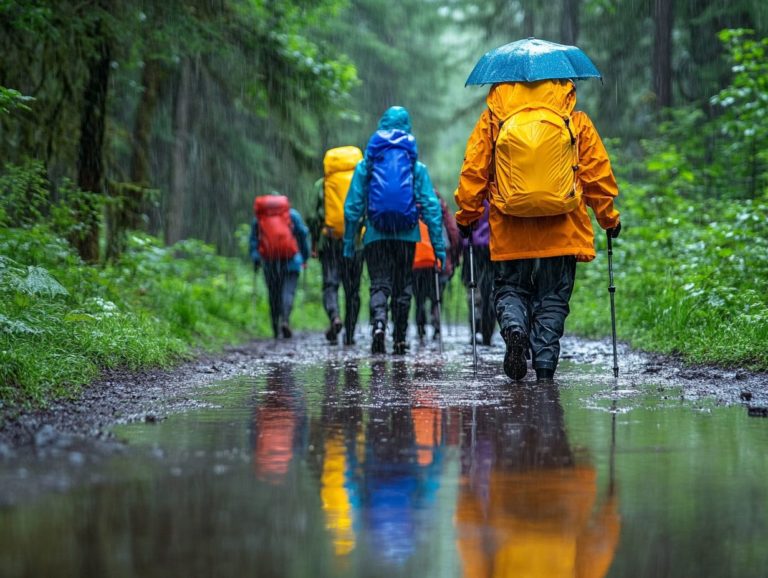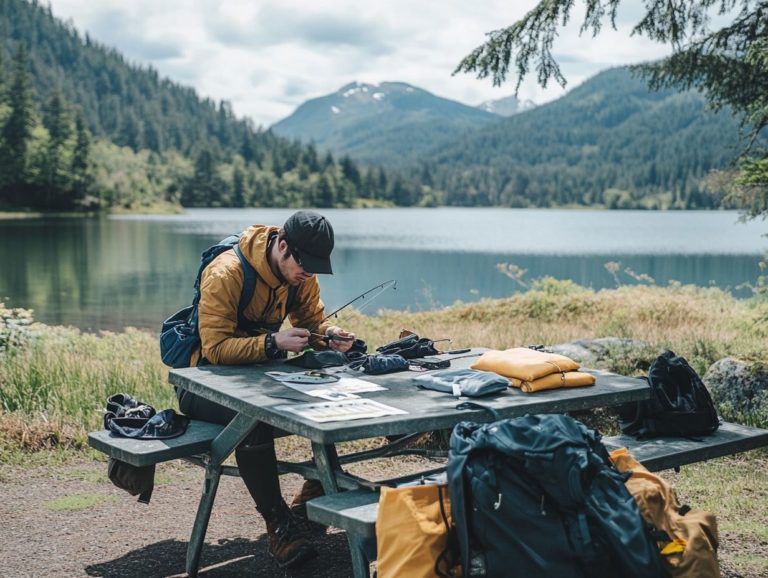How to Prepare for Changing Weather on Hikes
Hiking provides an extraordinary opportunity to connect with nature, yet unpredictable weather can swiftly transform a delightful trek into a daunting challenge.
From sudden rainstorms to unexpected drops in temperature, grasping the factors that influence weather during your hikes is essential for both safety and enjoyment.
This guide will delve into the crucial gear suited for any weather condition, how to plan your hikes with the forecast in mind, strategies for staying safe when the elements turn sour, and preparations for emergencies.
Get ready to make the most of every hike, rain or shine!
Contents
- Key Takeaways:
- Understanding Weather Changes on Hikes
- Essential Gear for Changing Weather
- Planning for Changing Weather
- Staying Safe in Changing Weather
- Emergency Preparedness for Changing Weather
- Frequently Asked Questions
- What Should I Pack for a Hike to Prepare for Changing Weather?
- How Can I Check the Weather Before Heading Out on a Hike?
- What Should I Do If the Weather Changes Unexpectedly During a Hike?
- Should I Bring Extra Water and Snacks in Case of a Weather Delay?
- Are There Any Specific Items I Should Pack for a Hike in Extreme Weather?
- What Should I Do If I Encounter Severe Weather on a Hike?
Key Takeaways:

- Always check the weather forecast before embarking on a hike and be prepared for sudden changes.
- Pack essential gear for changing weather, such as layers, rain gear, and a first aid kit.
- Create a weather-resistant hiking plan, including alternative routes and shelters, in case of inclement conditions.
Understanding Weather Changes on Hikes
Understanding how weather changes affect your hiking plans is essential for any outdoor adventure. Fluctuating conditions can profoundly impact your experience.
Factors like temperature, air pressure, humidity, and wind direction are crucial in determining your overall comfort and safety on the trail.
Whether you re exploring the majestic peaks of the German Alps or trekking along the Appalachian Trail, reliable forecasts and real-time updates can turn your journey into an unforgettable experience or transform it into a challenging ordeal.
Factors that Influence Weather on Hikes
Various factors play a crucial role in shaping weather conditions during your hikes, such as temperature, air pressure, and wind direction. Each of these elements can dramatically transform your hiking experience.
As you ascend, understanding these factors becomes even more important. At higher elevations, lower temperatures are the norm. Unexpected weather shifts can catch you off guard.
As you climb, air pressure decreases, making it essential for you to get used to higher altitudes to avoid altitude sickness.
Don t overlook humidity either; it significantly impacts your overall comfort. High humidity can make warm temperatures feel stifling, leading to quicker fatigue and an increased risk of dehydration.
By recognizing how these factors interact, you can better prepare for your adventures, ensuring a safe and enjoyable experience, no matter what the weather has in store.
Essential Gear for Changing Weather
Equipping yourself with the right gear is crucial for navigating the ever-changing weather conditions during hikes, ensuring both comfort and safety in unpredictable environments.
From lightweight layers to waterproof essentials, you must prepare to tackle various elements, whether it’s the sweltering heat of summer or the biting chill of winter.
Items such as well-designed hiking backpacks, light fleece, and suitable clothing can greatly enhance your hiking experience. This preparation allows you to immerse yourself in the beauty of nature rather than wrestle with the elements.
Must-Have Items for All-Weather Hiking

To ensure your all-weather hiking experience is nothing short of exceptional, pack specific must-have items tailored for varying conditions, such as sturdy hiking boots and adaptable clothing.
These essentials lay the groundwork for your comfort and safety on the trails. Durable hiking boots not only shield your feet from rough terrain but also provide vital support to help prevent injuries.
In terms of layering your hiking clothes, you can’t underestimate its importance for temperature control. Breathable base layers effectively wick moisture away, while insulating mid-layers trap warmth. Waterproof outer layers protect you from rain and wind. To ensure you’re ready for your adventure, check out this guide on how to prepare for a long hike. Opt for materials that dry quickly and offer versatility so you can easily adjust to the whims of changing weather.
Reliable rain gear is essential to stay dry and comfortable; the unpredictable nature of the weather can catch anyone off guard. A high-quality rain jacket will not only keep you dry but also maintain your body heat, ensuring you stay comfortable even in inclement conditions.
Planning for Changing Weather
Effective planning for shifting weather conditions is essential for ensuring a safe and enjoyable hiking experience. By preparing adequately for potential fluctuations, you re ready for an adventure no matter the weather!
Relying on trustworthy weather forecasts and real-time updates gives you the power to make informed decisions about your routes and gear. A solid navigation system, paired with timely forecast updates, will guide you confidently through varied terrains, no matter what the skies may have in store.
Creating a Weather-Resistant Hiking Plan
Creating a weather-resistant hiking plan is essential for navigating unpredictable conditions and ensuring a safe outdoor adventure. This involves several thoughtful steps to guarantee your preparedness.
- First, scout potential contingency routes that avoid hazardous areas while providing safe alternatives.
- Next, conduct thorough gear checks; ensure your clothing, footwear, and navigation tools are suited for the anticipated weather conditions.
- Designate reliable emergency contacts it’s vital that someone knows your planned route and can act promptly if delays occur.
- Ultimately, stay informed about seasonal changes and adjust your plans based on current weather forecasts. This proactive approach will significantly mitigate risks, allowing for a more enjoyable and secure hiking experience.
Staying Safe in Changing Weather
Navigating the unpredictable elements while hiking demands a set of essential skills and careful planning to confront inclement weather with confidence. As weather patterns evolve, you must remain vigilant about the array of outdoor challenges that could unexpectedly appear ranging from sudden rainstorms to drastic temperature drops.
By refining critical skills like navigation and evaluating possible dangers, you’ll not only bolster your safety but also elevate your overall experience in the majestic embrace of nature.

When navigating inclement conditions, having a reliable set of tips can be the key to transforming a potentially uncomfortable experience into a safe and enjoyable hike.
- In challenging weather think pouring rain or heavy snowfall it’s essential to adjust your pacing. This helps maintain stability and prevents slips.
- Regularly check visibility; fog or a snowstorm can easily obscure trails and landmarks, leaving you in a bind.
- Don’t overlook the impact of wind chill on ambient temperatures. Staying aware of how it affects your comfort and safety can make all the difference.
- Be prepared to adapt your routes and timelines in response to changing conditions. This way, you can savor your journey while minimizing the risks that come with adverse weather.
Emergency Preparedness for Changing Weather
Emergency preparedness for fluctuating weather is crucial for hiking safety. By recognizing the potential for sudden weather changes, you can take proactive steps to equip yourself with the knowledge and gear essential for unexpected situations.
Whether it s an unanticipated downpour, a sudden snowfall, or a drastic drop in temperature, being prepared greatly enhances your outdoor adventures and elevates your overall hiking experience.
What to Do in Case of Severe Weather
Knowing how to respond during severe weather can ensure your safety and survival.
Immediate action is essential. Your first step should be to locate the nearest shelter like a cave or rock overhang. Staying informed about changing weather conditions is critical; having portable weather radios or a smartphone on hand gives you the power to make informed decisions. Additionally, knowing how to stay warm while hiking can be invaluable in ensuring your safety.
If the situation gets worse, use emergency gear like a whistle or a reflective mirror to signal for help. This enhances your chances of being found by rescue teams. Open communication with fellow hikers is also crucial; sharing information can turn the tide in successfully navigating through the storm. Additionally, knowing how to stay comfortable while hiking can greatly improve your experience in challenging conditions.
Frequently Asked Questions
What Should I Pack for a Hike to Prepare for Changing Weather?

Don t forget to pack layers of clothing, including a waterproof jacket, a hat, gloves, and extra socks for comfort. Be sure to also bring sunscreen and bug spray.
How Can I Check the Weather Before Heading Out on a Hike?
You can use a weather app, like Windy.com, or a website to check the forecast for your hiking location in the German Alps or along the Appalachian Trail. It’s also recommended to check with local park authorities for any recent updates or warnings.
What Should I Do If the Weather Changes Unexpectedly During a Hike?
If you notice the weather changes unexpectedly, including shifts in temperature, rain, or wind direction, find a safe spot to stop. Reassess the situation, and consider turning back or finding shelter if necessary. Always prioritize hiking safety over completing the hike.
Should I Bring Extra Water and Snacks in Case of a Weather Delay?
Yes, it’s always a good idea to bring extra water and snacks in case you’re delayed by changing weather conditions such as high humidity or cold temperatures. This will help keep you hydrated and energized while waiting for conditions to improve.
Are There Any Specific Items I Should Pack for a Hike in Extreme Weather?
If you are planning a hike in extreme conditions, like high heat or cold temperatures, it s important to bring specialized gear such as insulated water bottles, weatherproof gear, light layers, and a first aid kit specifically designed for extreme weather situations. Ensure your hiking clothes are suitable for the temperatures you may encounter.
What Should I Do If I Encounter Severe Weather on a Hike?
If you are already on a hike and encounter severe weather, stay calm and quickly seek shelter in a sturdy building or low-lying area. Avoid open spaces, tall trees, and bodies of water. Once the storm passes, assess the trail conditions and visibility, and continue with caution or consider turning back to ensure your hiking experience remains safe.
Stay safe and prepare today!






